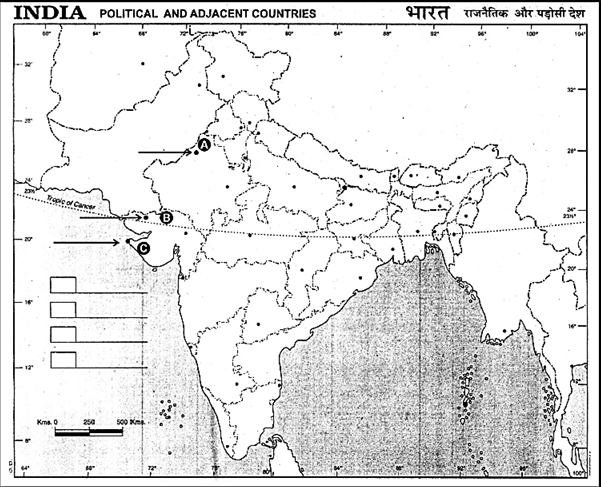 Short Answer Type
Short Answer TypeThe burials in Harappan sites reveal the economic and social differences amongst the people living within a particular culture. Give two evidences in support of your answer.
What evidences have been put forward to explain the collapse of the Harappan Civilization ?
On the given outline political map of India locate and label the following with appropriate symbols:
(a) Ajmer, a territory under Mughals.
(b) Gwalior, a centre of the Revolt of 1857.
On the same map three places related to the mature Harappan sites has been marked as A, B, C. Identify them and write their names correctly on the lines drawn near them.
Why were many Zamindaris auctioned after the Permanent Settlement in Bengal ? Give two reasons.
‘Kabir was and is to the present a source of inspiration for those who questioned entrenched social institutions and ideas in their search for divine.’ Explain.
“The nobility was recruited consciously by the Mughal rulers from diverse ethnic and religious groups.” Justify.
Examine the circumstances that led to the passing of ‘Limitation Laws’ by the British in 1859.
Highlight the measures taken to ensure unity among the rebels of 1857.
Measures adopted by the rebels of 1857 to ensure unity
(i) The rebel proclamations in 1857 repeatedly appealed for unity to all sections of the population, irrespective of their caste and creed.
(ii) Many of the proclamations (Azamgarh) were issued by Muslim princes or in their names but even these took care to address the sentiments of Hindus.
(iii) The rebellion was seen as a war in which both Hindus and Muslims had equally to lose or gain.
(iv) The ishtahars harked back to the pre-British Hindu-Muslim past and glorified the coexistence of different communities under the Mughal Empire.
(v) The proclamation that was issued under the name of Bahadur Shah appealed to the people to join the fight under the standards of both Muhammad and Mahavir.
(vi) Every aspect of British rule was attacked and the firangi accused of destroying a way of life that was familiar and cherished.
(vii) The rebels failed the attempt of the British govt. for inciting Hindu population against Muslims.
(viii) The rebels wanted to restore world of peace and unity.
(ix) Various sections of the Indian society promoted common good.
(x) Fears and suspicion amongst people that the brutish would destroy their faiths and convictions.
(xi) Fear and suspicion that British wanted Indian to convert Indian to Christianity.
(xii) They maintained communication links with sepoys.
(xiii) Local leaders played a significant role in keeping the unity
